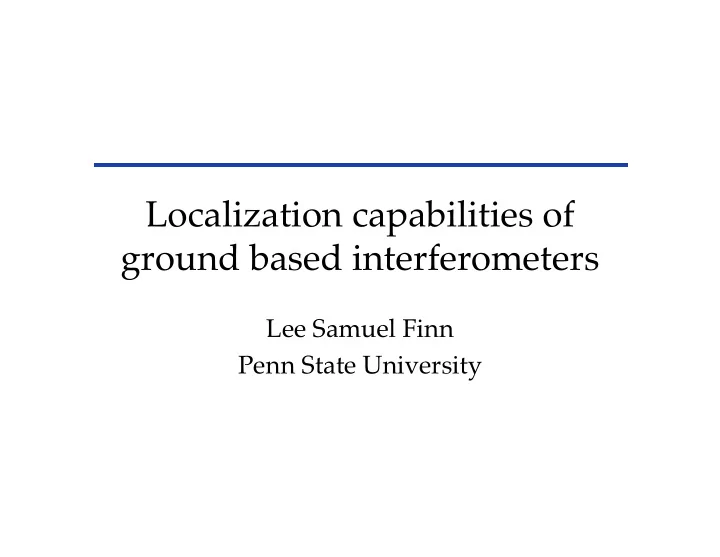

Localization capabilities of ground based interferometers Lee Samuel Finn Penn State University
Goal, assumptions, outline • Goal: How well can ground-based detectors localize gravitational wave sources. • Assumptions – Simultaneous observation by at least four geographically distinct interferometric detectors • Next 5y: LIGO (2) plus at least three of GEO, TAMA, Virgo • > 5 yr horizon: LIGO (2) plus at least three of ACIGA, GEO, LCGT, Virgo/Ego • Outline – Basic concepts – Methodology – Results
Basic concepts – Three detectors: • A single ground-based intersection of two circles interferometer has no – Four (or more) detectors: directional sensitivity to a single point (patch) inspiraling binaries • Arrival time? – NS/NS signal passes through band in ~ 20s – Define in terms of canonical feature of • Directional information signal: e.g., when is determined by time-of- instantaneous frequency arrival information at 100Hz. different detectors • Arrival time accuracy? – Two detectors: a circle in sky normal to axis between – No better than 0.1ms detectors (8/SNR)
Methodology • Wave incident direction n yields (relative) arrival times T. – T = A n • N detectors? A is Nx3 matrix whose rows are detector location vectors • Pick point in sky & determine exact arrival times T • Introduce timing errors dT – Assume normally distributed, zero mean, σ ~ 1 ms • Invert, in least squares sense, (T+dT) = A n’ to find best-fit angle of incidence • Find angle between n’, n • Repeat to determine error distribution
Results • GEO, LIGO, Virgo • Median localization error – I.e., half time error is greater, half time less • Error ranges by factor 2 – Maximum error when source direction normal to axis between detectors
Results: GEO, LCGT, LIGO, Virgo • Maximum error significantly reduced – Minimum error slightly improved • Mean error on sky significantly reduced
Results: Add an Australian Detector • ACIGA, GEO, LCGT, LIGO, Virgo • Maximum error reduced again • Mean sky error reduced further • Minimum error never gets better than ~2 degrees
With, without Australian Detector
Caveats and Conclusions • Assumption that all errors are the same – GEO much less sensitive than LIGO, Virgo to binary inspiral and will have greater timing errors. • Gravitational wave astronomy needs at least four, large, well separated detectors – Southern Hemisphere detector would be especially helpful
Recommend
More recommend